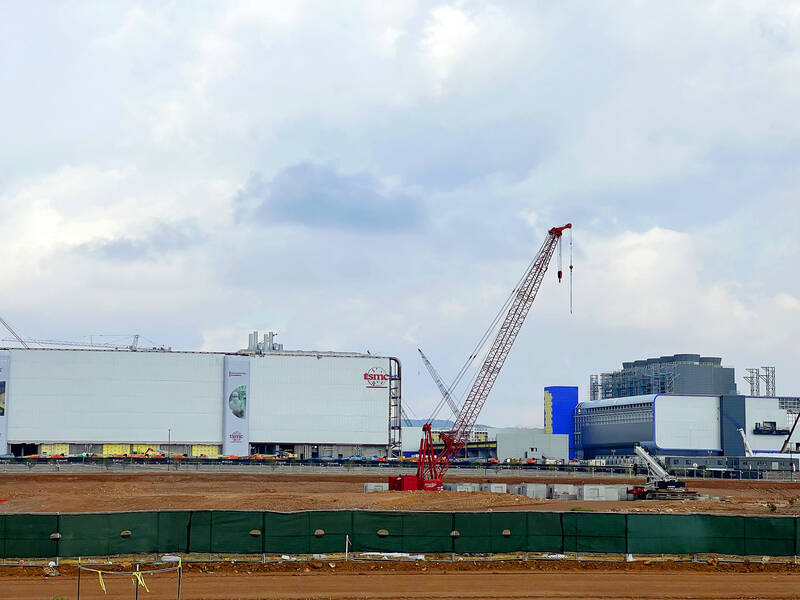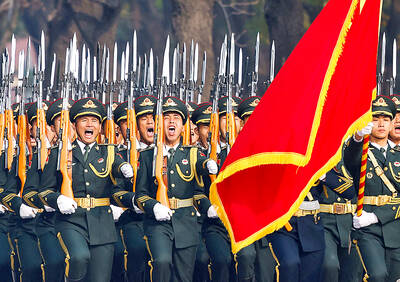Taiwan Semiconductor Manufacturing Co (TSMC, 台積電) yesterday said it is more than tripling its US investment to total US$40 billion as it plans to make 3-nanometer chips in 2026 at a second Arizona fab, adding to the chipmaker’s original plan of building a US$12 billion fab to make 5-nanometer chips in 2024.
The investment would mark the largest foreign direct investment in Arizona’s history and one of the largest foreign direct investments in the history of the US, the world’s largest contract chipmaker said in a statement yesterday.
In addition to the more than 10,000 construction workers at the site, TSMC’s two fabs are expected to create an additional 10,000 high-paying high-tech jobs, including 4,500 direct TSMC jobs, it said.

Photo: CNA
When complete, the two fabs would produce more than 600,000 wafers per year, with estimated end-product value of more than US$40 billion, the statement said.
“When complete, TSMC Arizona will be the greenest semiconductor manufacturing facility in the United States producing the most advanced semiconductor process technology in the country, enabling next-generation high-performance and low-power computing products for years to come,” TSMC chairman Mark Liu (劉德音) said in the statement.
US President Joe Biden was yesterday to visit the Arizona plant. The chipmaker’s investment is a big win for Biden after supply-chain issues disrupted the US economy early in his presidency.
Joining Biden on his visit to promote efforts to boost US technology manufacturing were expected to be Apple Inc chief executive Tim Cook, TSMC founder Morris Chang (張忠謀), Micron Technology chief executive Sanjay Mehrotra and Nvidia founder and chief executive Jensen Huang (黃仁勳), among others, the White House said.
They were to attend a “tool-in” ceremony, which is the symbolic moving of the first equipment onto the shop floor of the new US$12 billion facility.
The plant is scheduled to be operational in 2024.
“Bringing TSMC’s investment to the United States is a masterstroke and a game-changing development for the industry,” Huang said in remarks prepared for yesterday’s event.
US semiconductor production now accounts for just 12 percent of the global total, down from 37 percent two decades ago, a White House report on supply-chain problems last year said.
Taiwan’s dominant position as a maker of chips used in technology from mobile phones and vehicles to fighter jets has sparked concerns of over-reliance on the nation, especially as China ramps up its military pressure.
“The occasion for the president’s travel is to mark a significant milestone that TSMC is reaching in bringing the most advanced semiconductor manufacturing back to the US,” US National Economic Council Director Brian Deese said.

Conflict with Taiwan could leave China with “massive economic disruption, catastrophic military losses, significant social unrest, and devastating sanctions,” a US think tank said in a report released on Monday. The German Marshall Fund released a report titled If China Attacks Taiwan: The Consequences for China of “Minor Conflict” and “Major War” Scenarios. The report details the “massive” economic, military, social and international costs to China in the event of a minor conflict or major war with Taiwan, estimating that the Chinese People’s Liberation Army (PLA) could sustain losses of more than half of its active-duty ground forces, including 100,000 troops. Understanding Chinese

The Ministry of Foreign Affairs (MOFA) yesterday said it is closely monitoring developments in Venezuela, and would continue to cooperate with democratic allies and work together for regional and global security, stability, and prosperity. The remarks came after the US on Saturday launched a series of airstrikes in Venezuela and kidnapped Venezuelan President Nicolas Maduro, who was later flown to New York along with his wife. The pair face US charges related to drug trafficking and alleged cooperation with gangs designated as terrorist organizations. Maduro has denied the allegations. The ministry said that it is closely monitoring the political and economic situation

UNRELENTING: China attempted cyberattacks on Taiwan’s critical infrastructure 2.63 million times per day last year, up from 1.23 million in 2023, the NSB said China’s cyberarmy has long engaged in cyberattacks against Taiwan’s critical infrastructure, employing diverse and evolving tactics, the National Security Bureau (NSB) said yesterday, adding that cyberattacks on critical energy infrastructure last year increased 10-fold compared with the previous year. The NSB yesterday released a report titled Analysis on China’s Cyber Threats to Taiwan’s Critical Infrastructure in 2025, outlining the number of cyberattacks, major tactics and hacker groups. Taiwan’s national intelligence community identified a large number of cybersecurity incidents last year, the bureau said in a statement. China’s cyberarmy last year launched an average of 2.63 million intrusion attempts per day targeting Taiwan’s critical

AGING: As of last month, people aged 65 or older accounted for 20.06 percent of the total population and the number of couples who got married fell by 18,685 from 2024 Taiwan has surpassed South Korea as the country least willing to have children, with an annual crude birthrate of 4.62 per 1,000 people, Ministry of the Interior data showed yesterday. The nation was previously ranked the second-lowest country in terms of total fertility rate, or the average number of children a woman has in her lifetime. However, South Korea’s fertility rate began to recover from 2023, with total fertility rate rising from 0.72 and estimated to reach 0.82 to 0.85 by last year, and the crude birthrate projected at 6.7 per 1,000 people. Japan’s crude birthrate was projected to fall below six,